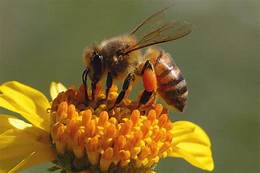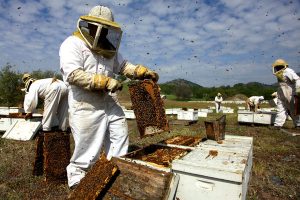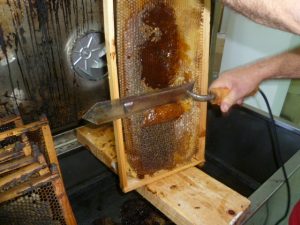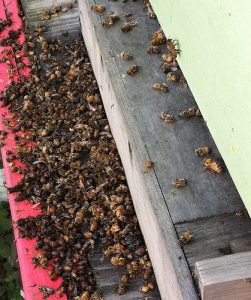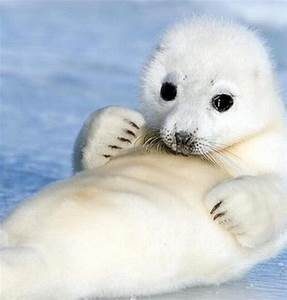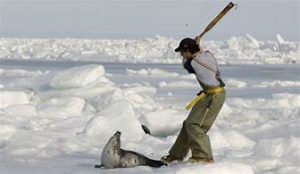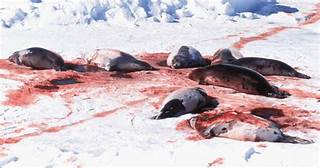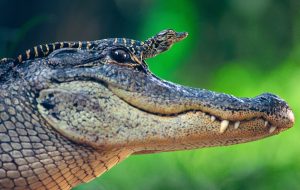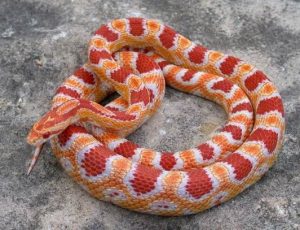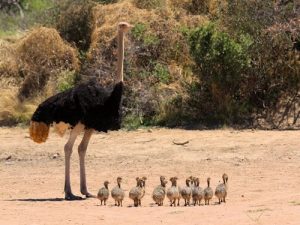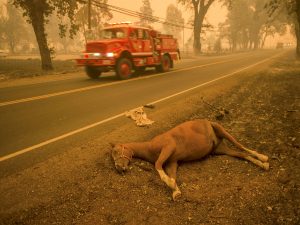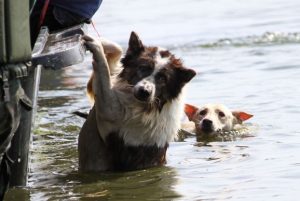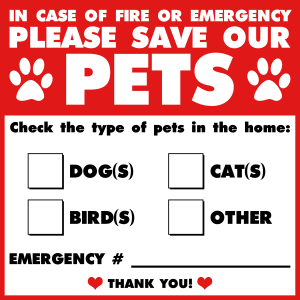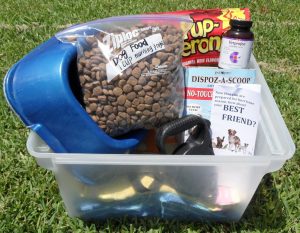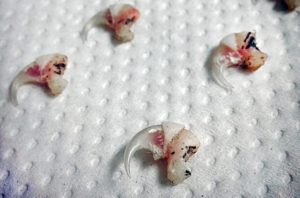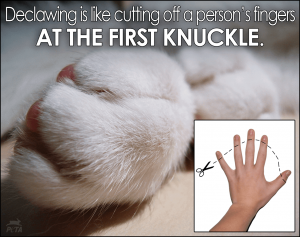 A few years ago, I visited Uganda where I photographed these beautiful elephants enjoying an afternoon stroll along a riverbank. African elephants are the largest land animals on Earth. They are a keystone species, meaning they play a critical role in their ecosystem. Also known as “ecosystem engineers,” elephants shape their habitat in many ways. During the dry season, they use their tusks to dig up dry riverbeds and create watering holes for other animals. Their dung is full of seeds, helping plants spread across the environment. In the forest, elephants feasting on trees and shrubs creates pathways for smaller animals to move through, and in the savanna, they uproot trees and eat saplings, which helps keep the landscape open for zebras and other plains animals to thrive. Once, these intelligent and social animals roamed across a large portion of Africa, but because of habitat destruction and poaching, they are now confined to 25 percent of their historical range. The exact number of elephants is difficult to track, but scientists estimate that the number has dropped from several million in the 1930s to less than 100,000 today.
A few years ago, I visited Uganda where I photographed these beautiful elephants enjoying an afternoon stroll along a riverbank. African elephants are the largest land animals on Earth. They are a keystone species, meaning they play a critical role in their ecosystem. Also known as “ecosystem engineers,” elephants shape their habitat in many ways. During the dry season, they use their tusks to dig up dry riverbeds and create watering holes for other animals. Their dung is full of seeds, helping plants spread across the environment. In the forest, elephants feasting on trees and shrubs creates pathways for smaller animals to move through, and in the savanna, they uproot trees and eat saplings, which helps keep the landscape open for zebras and other plains animals to thrive. Once, these intelligent and social animals roamed across a large portion of Africa, but because of habitat destruction and poaching, they are now confined to 25 percent of their historical range. The exact number of elephants is difficult to track, but scientists estimate that the number has dropped from several million in the 1930s to less than 100,000 today.
When most people think of poaching, they think about exotic animals on distant continents, but poaching and its consequences extend far beyond Africa, Asia, and other faraway places right into our own communities and even into our own homes. There are many species around the world that are poached, some right here in the United States. Their remains are used in various ways, often for luxury or pseudo-medicinal purposes. Here are some of the most common victims:
 Elephants: Elephants are poached for their ivory, which is carved into jewelry, utensils, religious figurines, and trinkets. To remove a tusk requires removing a very large chunk out of an elephant’s face and skull. Elephants are often chased into pits or poisoned, and their faces and tusks cut off while they are still alive. Approximately 70% of illegal ivory ends up in China, where it is sold on the street for up to $1,000 a pound. Conservationists estimate that between 30,000 and 38,000 elephants are poached annually for their ivory. At that rate, they will be extinct in 20 years.
Elephants: Elephants are poached for their ivory, which is carved into jewelry, utensils, religious figurines, and trinkets. To remove a tusk requires removing a very large chunk out of an elephant’s face and skull. Elephants are often chased into pits or poisoned, and their faces and tusks cut off while they are still alive. Approximately 70% of illegal ivory ends up in China, where it is sold on the street for up to $1,000 a pound. Conservationists estimate that between 30,000 and 38,000 elephants are poached annually for their ivory. At that rate, they will be extinct in 20 years.
Tigers: Tiger claws, teeth, and whiskers are believed by some superstitious cultures to provide good luck and protective powers. Some superstitious cultures believe their bones and eyes have medicinal value. In Taiwan, a bowl of tiger penis soup is believed to boost virility. Their skins are used to make coats and handbags. Fewer than 3,500 tigers are left in the wild; like elephants and rhinos, tigers are being poached to extinction.
Rhinoceros: The most expensive items in the world are gold, platinum, and rhino horn, with rhino horn topping the list. Rhino horn can sell for nearly $30,000 a pound. Gold, by comparison, is worth about $22,000 a pound. Their horns are believed to have aphrodisiac properties and are widely used in traditional medicines. Like elephants, they are driven into traps, killed, and their horns sawed off. Since 1960, the black rhino population has decreased by 97.6% due to poaching.
 Tibetan Antelopes: They are poached for their fur, which is commonly used as a light wool, and is in great demand world-wide. 20,000 Chirus, as they are called, are killed each year.
Tibetan Antelopes: They are poached for their fur, which is commonly used as a light wool, and is in great demand world-wide. 20,000 Chirus, as they are called, are killed each year.
Big-horned sheep: Poached for their antlers, which can fetch $20,000 on the black market.
Bears: North American black bears are poached for their gall bladders and bile, another pseudo-medicinal ingredient. A black bear’s gall bladder can fetch more than $3,000 in Asia.
 Gorillas: They are poached for their meat, captured for collections, and killed for trophies such as their hands, feet, skins, and skulls. Kidnapped baby gorillas bring $40,000 on the black market.
Gorillas: They are poached for their meat, captured for collections, and killed for trophies such as their hands, feet, skins, and skulls. Kidnapped baby gorillas bring $40,000 on the black market.
Lions: Another species fast disappearing, poached as trophies to prove an insecure human’s man(or woman)hood. It is estimated that 30% to 50% of Africa’s lion population has been illegally killed over the last 20 years. Last summer three poachers who broke into a South African game preserve to stalk and kill rhinos were attacked and eaten by lions, to which I say, justice was served.
Sharks: Sharks are poached for their fins, which some cultures consider a delicacy. Once caught, the fins are hacked off, and the still-living shark dumped back into the sea where it will soon die. Poached manta rays and sea cucumbers are also considered delicacies by some.
Red and Pink Coral: This is the most valuable type of coral, known for its use in jewelry and decorations. Not only does the poaching of coral effect coral population but it also effects the population of coral reefs and fish.
Blue Whale: Blue Whales have almost been hunted to extinction. They are poached for their blubber and oil, which are then used in candles and fuel.

Most poaching is done by organized crime syndicates who use high-powered technology and weaponry to hunt and kill animals without being detected. Poachers often prefer using poisoned arrows because there is not a telltale gunshot sound. A well-placed arrow can kill in 20 minutes; however, a misplaced arrow can leave an animal dying a lingering death from infection for up to a month. Poachers will often leave poison on the carcass of the prey to kill the vultures that might fly above and alert rangers.
Violent conflicts and ivory poaching are interconnected. Heavily armed militias and crime networks use ivory funds to finance terrorism and wars. Cash-starved terrorist organizations have turned to trading ivory, which the Elephant League has dubbed “the white gold of jihad.” The illegal wildlife trade nets $8 billion to $10 billion a year.
To combat poaching, in 2014 the United States banned the trade in African elephant ivory. Shamefully, the ban has been partially lifted by the current administration.
What can you do? Lobby your legislators to reinstate the complete ban and expand it to include poached animal products of every kind. Never buy ivory or coral products, whether new or used, or any other poached animal products, and boycott merchants who sell them. It’s only by making poaching less profitable that it can be reduced and the greed-fueled extinction of so many animal species reversed.
Peace to ALL the animals with whom we share this planet.


